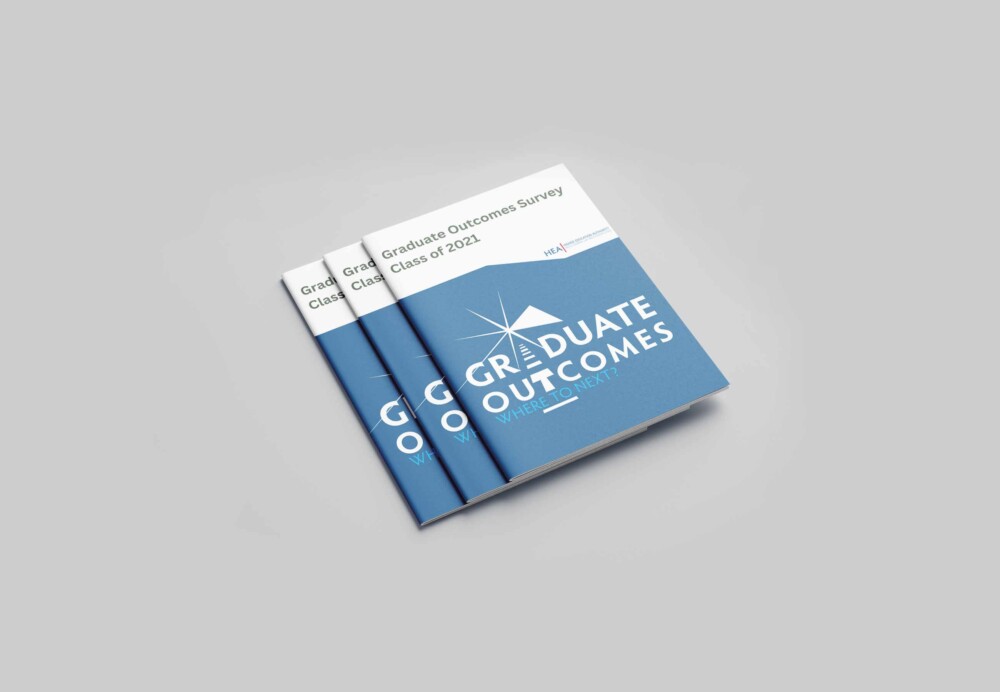HEA Publishes Graduate Outcomes and Disability Report
By Maura O'Shea
Posted: 23 February, 2023

The HEA today published a report on the findings of Graduate Outcomes and Disability Report. The report explores the graduate outcomes for graduates with a disability, and it does so by linking the HEA’s Equal Access Survey data with the HEA’s Graduate Outcomes Survey data.
The main findings in the report are as follows:
- A total of 69% of graduates with a disability were in employment nine months after graduation (full-time, part-time or due to start a job); and this figure ranged from 57% to 74% depending on the nature of the disability. This compares with 74% of graduates with no disability.
- The proportion of graduates with a disability pursuing further study (full-time or part-time) was 20%, compared with 19% of graduates without a disability. The figures for those with a disability ranged between 17% of graduates with a learning disability and 25% for graduates with multiple disabilities.
- A total of 7% of graduates with a disability were unemployed, compared with 5% of graduates with no disability.
- In terms of occupational groupings of employed graduates, 47% of graduates with a disability were employed in Professional occupations vs 56% of graduates with no disability. Between 41% and 53% of graduates with different types of disability were employed in Professional occupations.
- The most common sector of employment for all graduates was Human Health and Social Work Activities at 16% for graduates with a disability and 16% without. The sector with the largest difference was Financial, Insurance and Real Estate activities with 12% of graduates with a disability employed in this sector, compared to 16% of graduates with no disability.
- Across all graduates, permanent contracts were the most common form of contract type. A total of 56% of graduates with a disability had a permanent contract compared to 55% of those with no disability.
- 55% of graduates with a disability said that their course was either very relevant or relevant to their job; and this compares with 60% of graduates with no disability.
- Graduates with disabilities were more represented in each of the lower salary bands; up to salaries of €20,000-€24,999. In each band thereafter graduates with no disabilities had a higher share of their total group than those with a disability.
Chairperson of the HEA, Michael Horgan, said:
The release of today’s Graduate Outcomes Survey and Disability report is welcomed by the HEA. This report conducts in depth analysis of the outcomes for graduates with disabilities in of the Irish publicly funded Higher Education Institutions. This type of work is crucial for to ensuring equality and opportunity for our graduates, especially those with any form of disability. Our country can only flourish both socially and economically if we tap into the creativity, skills, and talents of our ever more diverse population.
NOTES:
Background
This report explores the graduate outcomes for graduates with a disability, and it does so by linking the HEA’s Equal Access Survey data with the HEA’s Graduate Outcomes Survey data.
The Equal Access Survey is an annual, voluntary set of questions asked of first year undergraduate students in HEA-funded institutions. The questions are asked as part of the registration process at the start of the academic year, and data is collected on student disability and the nature of that disability.
The Graduate Outcomes Survey is a national survey distributed to all graduates of higher education institutions (HEIs), nine months after graduation. On average, the response rate nationally is approximately 50%. The GOS database holds records of graduates who respond and do not respond to the survey.
Records were extracted from the EAS from 2007/08 to 2020/21 and were linked with Graduate Outcomes Survey returns for 2018, 2019 and 2021. All students who indicated that either they have a disability, or they do not have a disability, were linked with Graduate Outcomes Survey records. Records were matched across higher education institution, student ID and date of birth in both datasets. There is no linked EAS data available for 2018/19 due to Data Protection issues; however, this has a limited impact on the analysis presented here. This is because EAS data for those entering in higher education 2018/19 has few linked records with the GOS data under consideration (surveys in 2018, 2019 and 2021). There is no GOS data for 2020 due to the onset of the Covid-19 pandemic at the time of the survey fieldwork.
In total 9,888 EAS records found a matched GOS record. It is important to note, as above, that these are the total number of matched records, not the total number of available graduate outcomes survey responses. Of the 9,888 matched EAS-GOS records, a total of 60% or 5,937 had a graduate outcomes survey response.
Structure of Report
The report will be available in the form of an interactive, digital report, published on the HEA website. This includes the use of interactive tables facilitating more detailed analyses.
Link to interactive, digital report: https://hea.ie/statistics/graduate-outcomes-data-and-reports/graduate-outcomes-for-access-groups/1-graduate-outcomes-for-graduates-with-a-disability-foreword/
Readers can browse and explore data under the following Chapter headings:
- Foreword
- This chapter provides the policy context for the report.
- Introduction
- This chapter explains the methodology of the report and gives key findings.
- Methodology
- This chapter sets out how the data sets were linked and the types of disabilities various graduates with a disability had.
- Main Graduate Destination
- This chapter provides high-level findings on the main graduate destinations, nine months after graduation (employment, further study, other activity, unemployment) for graduates with no disabilities and graduates with a disability.
- Employment details
- This chapter provides more detailed findings on the sectors of employment, occupations, and contract types of graduates with no disabilities and graduates with a disability.
- Earnings Analysis
- This chapter examines graduate salaries for undergraduates and postgraduates for graduates with no disabilities and graduates with a disability.
- Further information
-
- This chapter gives contact details for those seeking further information.
Next Steps
The data release will be via data visualisations and a story visualisation on the HEA website on 23 February 2022. Much more detail will be included in the data release, including detailed earnings and employment analysis.


